The Value of Virtual Applications and Digital Equity

Augmented reality has seemingly had its "time and place" in our lives in the past decade, most notably through interactive games like Pokemon Go or other geocaching applications. So many business professionals and general consumers have filed it under the label of a luxury item that it is only good for entertainment purposes.
But little do many who turn a blind eye to the powers of A.R. know that there is a whole growing and disruptive world outside of this physical one we call home. A.R. is not "just a passing fad" or "some type of video game"; it has transitioned recently from a digital technological concept to a diverse and disruptive application implemented in so many different ways available to us.
From GPS systems to smart refrigerators, so many versatile technologies and characteristics of those technologies make up the concept of A.R. But the most notable environment that A.R. is really starting to shine in is not just in the physical products that A.R. is integrated into, but rather, the digital world those products connect to. Let's explore that landscape a bit further.
The Metaverse and Non-Fungible Tokens (NFTs)
Facebook announced late in 2021 that they would be rebranding to use the name "Meta," which for some may have meant next to nothing. However, they are much farther ahead of the game than even some experts realized, as what is now referred to as the "Metaverse" was in and of itself a Hard Trend future certainty long before the time of this writing.
Around the time of their rebranding, we started to notice an emergence of the acronym "NFT" dominating the news headlines. An NFT is a "non-fungible token," which, when compared to our tactile reality, is quite similar to a priceless work of art. Built and registered on the blockchain, an NFT is a digital token, design, or type of digital product that is unique in being the only iteration of it in existence.
NFTs have essentially brought legitimacy to digital art, and its value is measured in cryptocurrencies like Ethereum, Bitcoin, and others. And this creation, authentication, and exchange all happen without ever producing a single, physical item. So, what do NFTs and the Metaverse have to do with the concepts and traditional ideas of Augmented Reality?
The Metaverse is made up of a multitude of technologies run by digital devices in which people interact. Sounds quite a bit like social media or even email, doesn't it? The principles are quite similar, actually! For instance, you exist in the Metaverse as an Avatar of yourself and interact with others in the Metaverse by way of customs emulating the physical world. This includes the politics of exchange, communication, and basic cultural etiquette.
Now, NFTs in the Metaverse and their value are equivalent to physical goods we purchase in the real world from small businesses or big box stores. Digital currency giving you the ability to purchase digital products in a digital world may seem like an advanced version of the popular game from the early 2000s called "The Sims," where you live a second life, so to speak. However, the behavior of individuals in the Metaverse is simply a by-product of the actual disruptive technological functionality behind what runs all of these new A.R. applications.
A Case Study In Our Common World: Tonal Mirror and Digital Fitness
Wearable devices and other interactive technology in the fitness industry were and still are commonalities in so many consumers' lives. But the fact that Augmented Reality is at play in everything from Apple SmartWatches to FitBits and Peloton bicycles has been overlooked by dozens.
All these devices connect to some type of virtual landscape, where our equity is measured in calories burned, miles biked, steps taken, and even hours slept! That virtual landscape is very much part of the Metaverse, and often the interactivity involved is by way of gamification. For instance, the traditional way this is represented has been seen in FitBits, where you can start a step challenge with other family members and friends to see who meets their goals first.
One very recent digital device in the at-home fitness industry you may have noticed gaining traction is the smart mirror, notably by the company Tonal. Similar to Peloton, you actually pay a monthly fee, as you would for a membership to a gym, to have access to interactive training from a personal fitness coach, and ways in which you measure and document your progress in, you guessed it, a virtual landscape -- a Metaverse of sorts.
Similar to geocaching, Augmented Reality and physical fitness equipment are prompting you to partake in something physical that gets documented for digital equity of sorts. That equity may not at the moment come in the form of an NFT or pay you in cryptocurrency, as discussed earlier in this blog, but it is still a measurable asset valuable to your health.
These digital technologies are getting so streamlined that during the pandemic, many have personally preferred to make the shift to investing in at-home digital workout devices like Tonal's smart mirror instead of going to a physical gym, hiring an in-person physical trainer, and having no way to really measure the benefit from the specific activity the trainer had them do.
Augmented Reality and the Metaverse Are All-Consuming Hard Trends
At-home versus in-person preference aside, there is no question that A.R. and its newest iterations in the Metaverse are continuing as a Hard Trend that will quite literally impact everything we do. In a way, it already has; it is just going to get more streamlined than ever before.
Businesses had to move to a more augmented way of working in the virtual landscape brought about by the pandemic. Many had not only never utilized Zoom or Microsoft Teams, but they also hardly had a single thing in place to accommodate virtual workspaces. Now, communicating via remote work software like Basecamp, where tasks and due dates can be assigned and traditional email can be omitted, is becoming the standard for both virtual employees and ones that have gone back to the office.
What business leaders must do is take a long, hard look at A.R. and its current impact on the world inside and out of their own industries and start to develop an Anticipatory strategy around how it will further impact their industries and the world in the future. A.R. is a type of convergence between the digital and physical worlds, and there are so many areas that can and will be disrupted as this type of technology improves.
An example comes from looking at the concept of digital products like NFTs. Much of manufacturing has now transitioned to taking something digital and producing it into something physical, such as additive manufacturing with 3D printers. What about when we can more efficiently work and produce from within the realm of the Metaverse, where on-site employees wear A.R. glasses to receive instructions in real-time from off-site employees and not have to stop and check an email?
Above all else, look at A.R. and all the different iterations of it from the view of an Anticipatory Leader to get a handle on where your industry and organization will have to head to stay on top of any disruptions that will come as a result.









